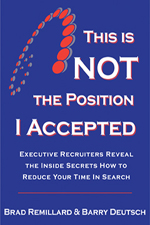Stop Your Job Search Until 2010 – Dumb Move
I get this all the time from candidates I’m working with in our job search coaching program. It usually starts with, “The holidays are here and nobody is hiring during this period.” or “Why look now? I will wait until the new year. It is time for a break.”
As succinctly as my mild manner can put it, DUMB MOVE. Sorry to yell, but that is what this attitude is. So let’s call it dumb.
In almost 30 years in the search business I have weathered 4 recessions, including this one. In every recession, including this one, I have active searches underway. I have filled many searches and started many searches during the holiday season. You don’t want to be left behind. For example, I will be starting a VP of Sales search today. Do you think I will wait until the new year to start the search process? NO WAY. I will be actively sourcing, interviewing and presenting candidates to my client as quickly as I can find them.
If you put your search on hold until 2010 I will probably not find you, not consider you, and by the time you reactivate your job search, I’ll already have candidates going through the hiring process. That means only one thing for you, you are probably going to end up in the backup group of candidates.
Let others put their job hunting activity on hold. You should continue yours, as aggressively as always.
5 reasons why you should:
1) If everyone else puts their search on hold, then there is less competition out there for you, making it easier for you to be discovered.
2) As stated earlier, the hiring process doesn’t stop during this period. It may slow, but it doesn’t stop. You only need one job opportunity. Don’t let that one opportunity pass you by.
3) Why stop the momentum you have built up? This by itself is a good reason not to stop your job search activity. Why on earth would anybody want to restart a job search? It is hard enough work to begin with, so let’s do it twice. Are you serious?
4) Use this time to establish momentum going into the new year. If you think hiring will wait until the new year, fine. Doesn’t it make sense then to proactively get a jump on this hiring activity? Why would you want to be reactive? Being reactive is rarely a good job search strategy.
5) This is a great time to re-evaluate your job search. Take a look back on 2009 and do some objective analysis of what worked and what didn’t work. Use this time to get help. Read some books, listen to CDs, engage an expert. Every process needs to be analyzed. The key is objectively. If you can’t do that, then get someone to help you. You can’t fix what you don’t know isn’t working. Download our tool, Job Search Self-Assessment Scorecard, to help with this analysis. It is FREE and a good place to start. CLICK HERE to download yours.
This is the time to put your ego aside and listen, learn and adapt.
Don’t put your search on hold during this holiday season. Instead use this time wisely to out-smart the competition, get a leg up on the competition and be proactive.
Another tool to help you is our skills assessment worksheet. This is a good time to take an inventory of your transferable skills and put a plan together to get whatever skills you may be lacking. CLICK HERE to get your free skills assessment. Scroll to the bottom to the What’s New Section.
Finally, join our Job Search Networking Group on Linkedin. Over 3300 members have joined. This is an active group with a wealth of resources, discussions and articles to make sure your job search stays on track. It is FREE to join. CLICK HERE to join.
I welcome your thoughts, feedback and comments.
Brad Remillard







